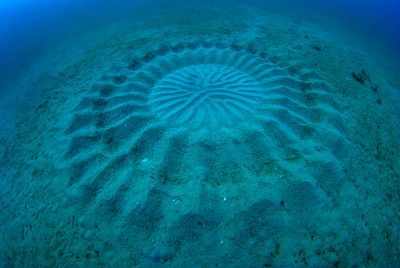Seabed circles ‘Whodunnit?’ solved

In 1995, divers off the coast of Japan discovered a circular structure about two metres (6 ft) in diameter carved in the seafloor sand. Consisting of multiple ridges symmetrically radiating out from a small patterned circle in the centre, more of these geometric seabed formations were soon discovered nearby. These ‘underwater crop circles’—as some dubbed them—mysteriously came and went, and “appeared to be the work of an underwater artist, carefully working with tools. … But who or what created them?”1
For more than a decade, this ‘Whodunnit?’ remained a mystery. But researchers now know that the creator of these seabed circles is a diminutive pufferfish, just 12 cm (5 inches) long.2,3 It takes 7–9 days of laborious construction work for a male pufferfish to build one, apparently with a goal of attracting a mate. If he succeeds, she lays her eggs in the centre circle, where the sand is finest. Indeed, it seems the fine-grained sand is a key ‘selling point’. When a female approaches the male’s seabed handiwork, he deliberately stirs up the fine sand of the central circle for her to see.
These pufferfish constructions have three characteristics never before seen in fish nests shaped in sand: the radially aligned peaks and valleys; the peaks decorated with shell fragments; and the fine sand particles gathered in the central circle. What’s more, the total circular structure itself helps to gather the fine sediments into the centre. Researchers conducting a fluid dynamics test observed that the upstream portion of the peaks and valleys funnel water and fine sediments toward the centre. Then, the downstream peaks and valleys funnel the water outward. The speed of water was slowed by nearly 25 percent in the central circle, allowing the fine-grained particles borne along by the current to settle there.

So these seabed circles with their fine-grained centres are no accident—it was quite right to see them as presenting a ‘Whodunnit?’ question needing to be solved. But if something as relatively ‘simple’ as strategically heaped sand ridges/circles point to their needing a creator, how much more so the staggeringly intricate and complex puffer fish, able to live, breathe and reproduce, must itself be the artistry of a creator? The Bible warns us not to overlook the fact that living things present us with a ‘Whodunnit?’ question (Romans 1:20)—which it also solves for us (e.g. Genesis 1, Revelation 4:11).
References and notes
- . Japan crop circle mystery solved 2012 HD, youtube.com/watch?v=WIbdnx7Q-JU&spfreload=10, acc. 24 April 2017. Return to text.
- . Main, D., Pufferfish love explains mysterious underwater circles, livescience.com, 2 October 2013. Return to text.
- . Kawase, H., Okata, Y., and Ito, K., Role of huge geometric circular structures in the reproduction of a marine pufferfish, Scientific Reports 3:2106, 1 July 2013, doi:10.1038/srep02106. Return to text.




Readers’ comments
Comments are automatically closed 14 days after publication.